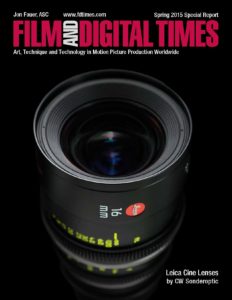Newly updated Spring 2015 Edition. This is the free online PDF version of the printed copies handed out at NAB and available in the LA Leica Gallery. (previous edition was Photokina 2014). 126 pages.
Perhaps lured by the glamor and excitement of the movies, dreams of exotic locations, and life outside the laboratory, Oskar Barnack built a 35mm motion picture camera in 1912.
Oskar Barnack wrote, “I joined the Ernst Leitz Optical Works in Wetzlar. Here my responsibilities included, among other things, motion picture technology. I designed my first motion picture camera in 1912 and pretty soon I was headed in the right direction because of the fine grain of motion picture film. A postcard size enlargement from a motion picture frame was quite acceptable. It is really true that, the larger the picture, the more plastic and realistic its effect.
“For that purpose the motion picture frame was too small. Since regular film unfortunately was not permitted to become wider because of the wonderful invention of standardization, I had to employ as much feasible length in order to make optimum use of it. Right off, I tried to double the frame width and what do you know, it worked out very well; that is, 24 mm wide and 36 mm long. That is how the Leica format came to be.”
In 1924, Ernst Leitz approved production of Barnack’s Leica format 24 x 36mm still camera. His famous words, “I hereby decide: let’s risk it,” was pretty risky at the time, although there is some speculation that the meeting had dragged on for hours and Mr. Leitz was eager for lunch.
The prototype “Liliput” camera, as Barnack called it, would later be referred to as the “Ur-Leica.” But why was Barnack’s Ur-Leica developed and his motion picture camera remained a singular model, now prominently on display in the lobby of Leica Camera’s new headquarters in Wetzlar?
Dr. Andreas Kaufmann, Chairman of Leica and a former history professor, thinks it was a matter of economics at a time of massive inflation. Mechau’s projector was extremely expensive. In 1911, the famous Bell & Howell 2709 was introduced: hand-cranked, cast aluminum, 4-lens turret with rackover for focus and viewing.
It would be another hundred years for Leica Camera to get back to 35mm motion pictures with their Leica Summilux-C and Summicron-C lenses—the subject of this special report.
Best viewed in Adobe Acrobat with View-Page Display set to Two Page View, and Show Cover Page in Two Page View. © 2014 Film and Digital Times.








